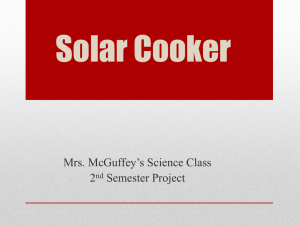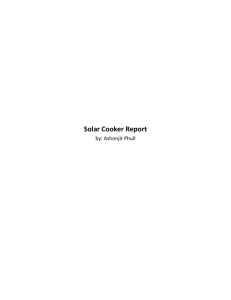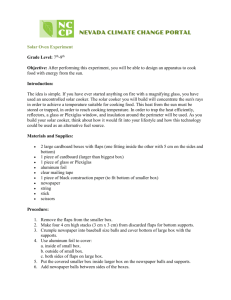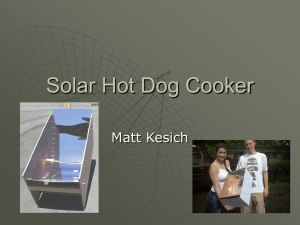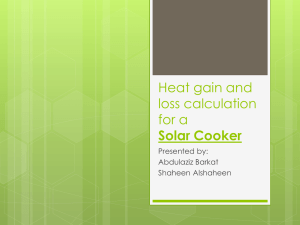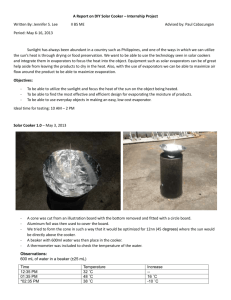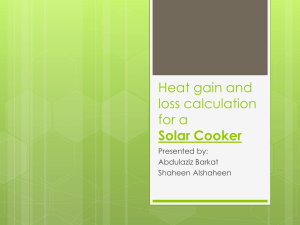Physics M4 Thermal Physics PBL Report
advertisement
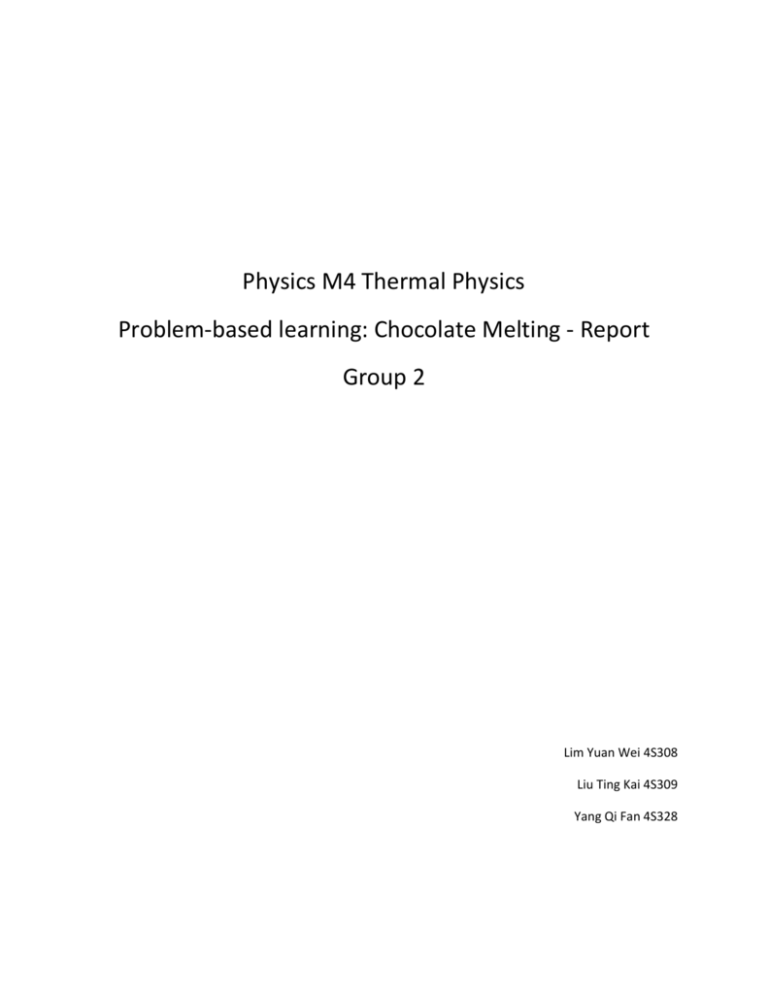
Physics M4 Thermal Physics Problem-based learning: Chocolate Melting - Report Group 2 Lim Yuan Wei 4S308 Liu Ting Kai 4S309 Yang Qi Fan 4S328 Contents - Introduction Literature Review Preliminary Designs Trial Final Design Final trial Images of prototype and final setup Reflections Introduction Basically, the thermal physics PBL for this term is to construct a solar cooker to melt a chocolate chip, which is to say to solely use the thermal energy radiated out from the sun in the day to melt a chocolate chip. But more importantly, the efficiency of the solar cooker itself is more important, as leaving the chocolate chip on its own in the sun to melt can be done by just anyone. This cannot be said for melting it most efficiently and in the shortest amount of time possible. Hence, the main focus is to design a cooker that can fully utilize the thermal energy and focus it onto the chocolate chip itself to melt it as fast as possible. Literature Review Before attempting to create and come up with our own solar cooker, our group did a mini literature review on the web to determine the various means and methods as to which has been deemed effective as solar cookers by others. From our research, we have determined that there are three main types of solar cookers, namely box, panel, and parabolic. A brief description and the evaluation of their pros and cons are shown in the table below. Type Pros Cons Box -Larger capacity, can contain more items -Can be built from a wide variety of different materials, allowing greater flexibility -Don’t have to be continuously adjusted to face the sun -Long construct time as compared to panel -Can’t reach high temperatures and thus unable to fry food Panel -Easy and cheap to make Can be collapsed for transport and storage Parabolic -Able to achieve extremely high temperatures, hence cooking almost as fast as conventional electric burner -Can fry food as a result of high heat -Lower temperatures can’t fry food -Can contain little amount of items to cook -More costly -Requires periodic adjustment to the sun Image for reference After considering the various styles of solar cookers, our group decided to choose the parabolic cooker as the base design for our solar cooker. This is so as we feel that it is able to best achieve the PBL’s intended aim, which is to cook the chocolate chip as fast as possible. Moreover, advantages of other cookers were not really applicable to our PBL, such as the box cooker’s large capacity, as the chocolate chip itself is relatively small, hence does not require much space. Additionally, we felt that the con of the parabolic cooker of requiring periodic adjustments to the sun was not really much of an issue in our case. This is primarily so as we are intending to melt the chocolate chip as fast as possible, and hence movement of the sun would be negligible in a short period of time. Preliminary designs Our preliminary designs were very much based on a parabolic cooker, after having evaluated the various aspects of the varying types of solar cooker. Basically, our first idea was to create a parabolic solar cooker by constructing multiple mirrors in a curved array to reflect the sunlight to a particular point, and to add a frame to the mirrors such that it is held above ground, is able to tilt according to the sun’s movement, and able to hold a black container at the focal point with which the chocolate chip will be placed. However, we soon realized that having many mirrors held in place to reflect the sunlight to a particular place was not exactly easy to construct as the frame had to support too many various parts, hence we decided to edit the idea by replacing the mirrors with a single curved one which would have the same function, but allowing us to construct the entire solar cooker with greater ease. Moreover, we also considered the feasibility of adding a magnifying lens to the solar cooker such that it is above the black container and that its focal point is aimed at the container. However, we felt that the additional frame needed to hold the magnifying lens and the shadow it would create would be much too troublesome and would affect the amount of sunlight reaching the curved mirror and thus amount of sunlight that is reflected back towards the container. Application of physics concepts Our preliminary idea was largely based on the knowledge that we gained from the transfer of thermal energy and or thermal physics related concepts. We chose a curved mirror, which is painted silvery, to reflect light as smooth and silvery surfaces are poor absorbers of thermal energy, which in this case is thermal radiation. As such, they would not absorb the solar energy when reflecting it towards the container. Moreover, smooth surfaces are better at reflecting the solar energy back towards the container, as opposed to rough surfaces. Additionally, the container is also painted black for black surfaces are better absorbers of thermal energy, and as such, will heat up faster than other coloured surfaces, thus when the chocolate chip is placed inside the black container, as a result of the higher temperature of the container, there will be higher rates of thermal energy transfer via conduction, due to a larger gradient in temperature between the container and the chocolate chip, and hence the chocolate chip will melt at a faster rate. Trials Having managed to obtain the required materials, we assembled the solar cooker itself, and attempted to test it outdoors. For the first few tests, we did not really record down temperature, but attempted to see the amount of energy the solar cooker was able to generate. As such, we placed varying amounts of water to see the temperature that it could reach, and as to whether it was able to boil. As the temperature of the water obtained was rather satisfactory, for increases in the temperature of water indicates that there is indeed lots of thermal energy reflected, due to water’s high specific heat capacity, we then went on to test the solar cooker using a temperature probe. The results of the temperature recorded are as shown below. 100 80 60 40 Temp 20 0 0 50 100 150 200 250 300 350 400 450 500 550 600 650 700 750 800 850 900 Temperature/degree celsius Graph of temperature obtained from solar cooker Time elapsed/seconds On the day of the trial, it was slightly cloudy for first 500 seconds into the trial itself, and hence there is a very slow rise in temperature recorded. However, the cloud cleared at about the 540 second, and the temperature of the solar cooker had a sudden jump in temperature to slightly less than 90 degree Celsius in a span of 1 minute or so, and remained almost constant before the clouds blocked out the sunlight again at about the 780 second, whereby temperature began to decrease gradually. Based on the temperature recorded from the temperature probe, our group was rather satisfied with the maximum temperature obtained, as 90 degrees Celsius was sufficient to effectively melt the chocolate. However, we were also concerned with the fact that in the case of a lack of direct sunlight, the solar cooker was not able to efficiently melt the chocolate chip, for it was barely able to reach 40 degrees Celsius. Design Process Final Design Based on the results gathered from the trials, we were confident that the solar cooker would be able to work effectively under sunny conditions, but not fairing as well under cloudy weather. Moreover, another area of concern was that the melting exercise would be conducted on the rooftop of the science block, where there might be a chance of stronger winds, which may result in cooling of the ambient around the solar cooker itself, and hence loss of temperature from the black container. Hence, on top of the solar cooker, our group decided to make a large box to fit the solar cooker into. The sides of the box would be made from cardboard, whilst the top layer would be covered with a film of PVC. We felt that by adding a box around the solar cooker, in the event of a lack of direct sunlight due to cloudy weather, the air within the box can be easily heated by indirect sunlight, thereby making the setup relatively more effective. In addition to the PVC roll on top of the box, we lined the insides of the box with aluminum foil, but only regions above the curved mirror. Moreover, we also removed the black container, as although it is efficient in melting the chocolate chip, the requirements of having to suspend the chocolate chip on top of a toothpick would not be suitable for us to place in the container as the chocolate chip would not be in contact with the black container. Application of physics concepts In lieu with the physics concepts we have learnt, we decided to create a semi greenhouse effect by sealing the solar cooker within a box that allowed light to enter. This would prevent the loss of heat energy via convection, whereby in the absence of the box, air heated by the solar cooker would rise and hence carry the thermal energy away. By having the box, the air will be trapped within the box itself, and hence will get heated up but will not be able to escape via convection currents to the surrounding atmosphere, hence increasing the temperature within the box and making it more efficient for the chocolate chip to melt. Moreover, we used cardboard to construct the box as cardboard traps a layer of air between it, and since air is a poor conductor or thermal energy, minimal heat loss will occur at the sides of the box due to little energy escaping via conduction, thereby enhancing the amount of thermal energy trapped within the box and making the solar cooker more efficient overall. On top of that, cardboard is in itself a poor thermal conductor, and hence there will be reduced heat energy loss. Additionally, as aluminum foil is relatively smooth and silvery, we decided to line the inside of the box with it for it can aid the amount of light reflected onto the chocolate chip itself, thus increasing the rate at which it melts. This will also prevent a wastage of sunlight falling onto the box and getting absorbed by the box and not used to heat up the air within the box and the chocolate chip itself. The rationale of only lining the top of the box was because the bottom parts were almost totally shielded by the curved mirror of the solar cooker, hence we felt that adding the aluminum foil to the bottom parts would only be a waste of materials and not bring about much good in making the entire setup more efficient. Final Trial Once we have constructed a box to house the solar cooker, we carried out another trial to test the entire setup’s efficiency. Below is a graph of the temperature of the setup recorded by the temperature probe. 90 80 70 60 50 40 30 20 10 0 Temp 0 90 180 270 360 450 540 630 720 810 900 990 1080 1170 1260 1350 1440 1530 1620 Temperature/degrees celsius Temperature of solar cooker Time elapsed/seconds On the day of the testing, the temperature fluctuates according to the amount of direct sunlight received, increasing to about 80 degrees Celsius in the presence of direct sunlight and dropping to a low of about 50 degrees Celsius in the absence of direct sunlight. As a result of the large amounts of cloud, there were pockets of sunlight at times shining onto the solar cooker, and hence the highly fluctuating temperature recorded by the probe. However, based on the data obtained, we can see that despite a lack of direct sunlight, the additional box containing the solar cooker has definitely helped to reduce heat energy loss from the entire setup to the surroundings. This can be seen from the fact that the solar cooker is able to maintain at about 50 degrees Celsius at its lowest despite a lack of direct sunlight, which was an extremely great improvement from the maximum 40 degrees Celsius recorded by the solar cooker without the box in little direct sunlight. As such, we feel that with a higher constant temperature of 50 degrees Celsius even in the absence of direct sunlight, the solar cooker would still be able to melt the chocolate cooker with a greater degree of efficiency, albeit lesser than in the presence of direct sunlight. Images of prototype and final product Prototype Box for solar cooker Close up of final product Final Product Reflections Based on the timing that we obtained for melting the chocolate chip of 28 seconds, our group is rather satisfied with the amount of thermal energy the entire setup is able to generate from the direct sunlight it received, and we must say that we are quite amazed at the overall efficiency of the solar cooker, as it is able to achieve a maximum of almost 90 degrees Celsius, which is almost close to being able to boil water. However, we feel that there is still room for further improvements in our design, as upon observations of other groups using magnifying glass, we have come to realized that maybe if we had thought of a better way of implementing the magnifying glass to our setup, the entire setup might be more efficient and effective. Moreover, we feel that we were not really flexible in changing to the stipulated guidelines as removing the black container was rather troublesome for us for we had to rethink out how to hold the chocolate chip and how best to heat it up. Additionally, maybe the parabolic solar cooker was not as suitable a choice, due to the problems of having to tilt the curved mirror such that the focal point was directed at the chocolate chip. A box cooker might have sufficed to melt the chocolate chip as moderately high temperatures might be sufficient.
